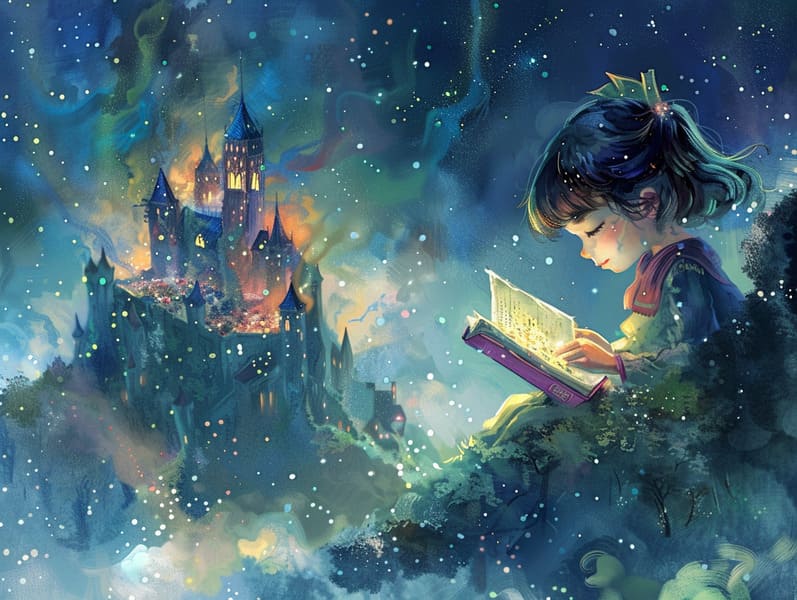
Short fairy tales have legendary status. These narratives have been whispered from one generation to the next ages before they were ever documented. They sprang from a variety of civilizations, including Western traditions. They were initially passed along among grown-ups, often carrying themes and messages relevant to the societal norms and beliefs of the time.
The Brothers Grimm, Jacob and Wilhelm Grimm, were among the first to collect many of these beloved stories. Their compilation, "Grimm's Folk Tales," included tales like "The Story of Cinderella," "Hansel and Gretel," and "Snow-White and Rose-Red," which have since become hallmarks in the world of beloved fairy tales. Similarly, H. C. Andersen's fanciful stories, such as "The Sea Maid," and "The Ugly Duckling," have captivated hearts worldwide, cementing their place in the pantheon of iconic fairy tales.
Despite their historical roots, traditional fairy tales remain as impactful as ever, especially as children's night stories. These whimsical stories are now available in diverse formats, including vividly illustrated books, magical animations, and free fairy tales online.
Their ongoing significance can be linked to several enchanting factors:
Vital Lessons: Ancient fairy tales often teach important moral lessons. Narratives like "The Boy Who Cried Wolf" teach the significance of truthfulness, while "The Tale of the Tortoise and the Hare" point out the benefits of persistence and unassuming nature. These stories offer little ones clear distinctions between moral and immoral, developing their moral compass in a kind yet lasting way.
Empathy and Awareness: Fairy tales frequently involve individuals facing trials and tribulations, motivating readers to empathize with their struggles and root for their triumphs. For instance, "Beauty and Her Beast" shows us the virtue of appreciating inner worth to appreciate the inner being of a individual, fostering insight and awareness.
Cultural Insights: Many classic fairy tales are deeply ingrained in the cultural contexts from which they grew. Engaging with these fairy tales can provide informative snapshots into different societies, enhancing a sense of global insight and understanding.
Creativity and Fantasy: The whimsical elements in old fairy tales—talking animals—foster children’s visions. These fairy tales take readers to otherworldly realms, enhancing fantasy-filled thoughts and a sense of fascination that persists a lifetime.
Old fairy tales are not only charming but also educational. They function as magical tools in cultivating various brain and heart skills in young ones. When classic fairy tales are spoken, they enhance verbal skills by presenting new vocabulary and intricate sentence structures. This practice also improves auditory perception and concentration, as children keep up with the story, prepared to see what happens next.
Furthermore, conversing about the themes and characters of traditional fairy tales can promote cognitive skills these guys and logical thinking. Little ones are taught to identify patterns, predict happenings, and know cause and effect. These debates also promote young readers convey their thoughts and feelings, fostering their emotional intelligence.
In today’s technological age, the abundance of online storybooks has made these fairy tales more attainable than ever. Web-based platforms and programs give wide arrays of traditional fairy tales that can be enjoyed or listened to anytime, anywhere. Fairy tales read aloud are particularly prevalent, presenting an delightful method for young ones to appreciate these whimsical stories. Narrated books and read-to-me stories take characters and settings to life, often complemented by whimsical background sounds and music that heighten the narrative journey.
The timeless allure of ancient fairy tales lies in their ability to adapt to today's society while keeping their core messages. Contemporary reinterpretations of these narratives often spotlight more multicultural characters and modern settings, making them pertinent to today’s audience. However, the main ideas of fortitude, sympathy, and righteousness remain unchanged, continuing to affect kids of all ages.
Fairy tales also offer a sense of protection and homeliness. They offer a structured narrative with a evident beginning, middle, and end, often concluding with the culmination of conflicts and the triumph of morality over wickedness. This assuredness can be placating for young ones, affording a sense of unchangeability in an dynamic world.
Classic fairy tales continue to captivate and guide new generations, maintaining their attraction and value in modern society. As kids' bedtime tales, they disclose a perfect blend of fascination and comprehension, boosting moral values, empathy, and creativity. The presence of digital storybooks and the well-liked nature of fairy tales voiced certify that these ancient narratives remain accessible to new generations.
By continuing and releasing these tales, we continue to acknowledge the rich tapestry of inventiveness and cultural heritage. Whether you are enjoying a richly illustrated book, discovering a electronic library, or listening on an read-aloud book, the charm of popular fairy tales is always within reach. These fairy tales demonstrate of the eternal ability of storytelling and its ability to connect us across time and space.
No matter if you are browsing a richly illustrated book, browsing a cyber collection, or listening through an sound book, the wonder of timeless fairy tales is always within reach.
These fairy tales illustrate of the unfading strength of tales and its ability to gather us across eras and regions, forming a connection that delights and instructs alike.